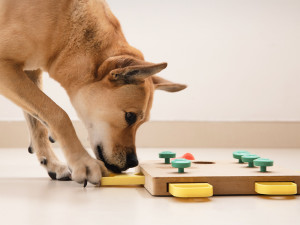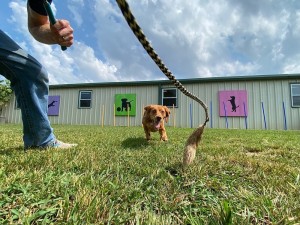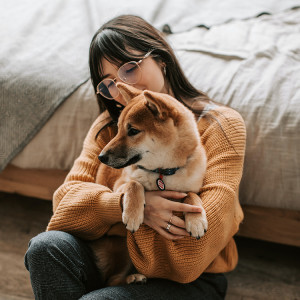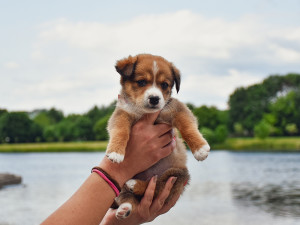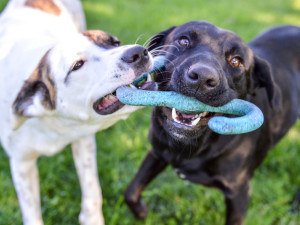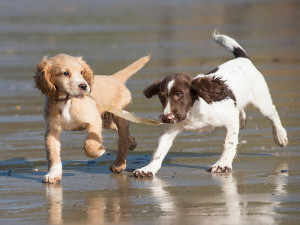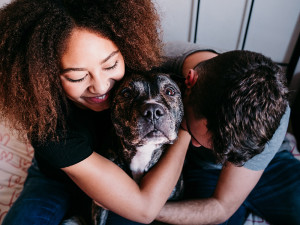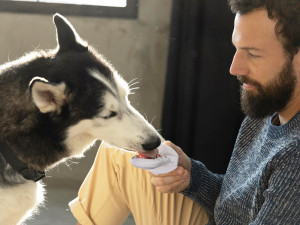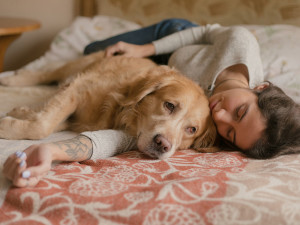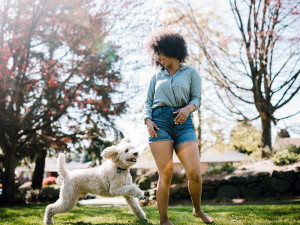Is My Dog Lonely? Experts Weigh In On If Your Dog Would Be Happier With Another Dog
Pets reduce loneliness in humans, but sometimes it’s hard to tell if things work the other way around.

Share Article
Over a year ago, I brought home a puppy. My husband and I sleep-trained her, helped her master potty training, and taught her how to sit on cue and how to fetch. Because we’d taken on the responsibility of caring for a living thing and because she’s so cute, we’ve done everything in our power to give her a shot at that elusive thing we humans are always after: happiness.
When it was obvious that she didn’t like her puppy food, we scrambled to find food toppers that would accommodate her taste. When she made it clear that she preferred to sleep on one bed over the other, we sold the offending mattress and got her a second version of the one she likes.
When she made it extremely clear that she hated car rides, we worked in incremental steps to reduce her fear around the big four-wheeled monster. And when that didn’t totally work, we invested in anti-nausea and anti-anxiety medications to ease her discomfort. We are, we like to think, doting parents to our only child.
But something has been nagging at us, especially as we stare into her perfect, fur-trimmed eyes and wonder what is going on in that tiny brain of hers: Does she suffer from the thing that so often gets in the way of human happiness? That is, is she lonely, and she simply can’t tell us? Are we, our dog’s biological mother and father (don’t bother telling us otherwise), enough for her? Or does she need a doggie social life? Or, better, do we need to get a dog for our dog?

What does science say about loneliness in dogs?
Though there is a lot of literature on dogs’ impact on human loneliness, there isn’t much research on dog loneliness specifically. The closest thing we have is researchopens in new tab by Dr. Noah Snyder-Mackler, an associate professor at the School of Life Sciences at Arizona State University (ASU). His team found that “social connectedness,” either with humans or fellow dogs — was the biggest predictor of a dog’s longevity. However, the study researched social connectedness among several other key factors in a dog’s life, so if or how dogs experience loneliness wasn’t isolated for study.
The one thing we do know is that dogs are social animals, evolutionarily speaking. They worked collaboratively to survive. Dr. Vanessa Spano, director of veterinary services at the ASPCA Adoption Center in New York City, tells us that what we lack in clinical studies on dog loneliness, we can just begin to make up for in the study of dog evolution.
“Although Fluffy the Shih Tzu is not a wolf, her ancestors in the wild did cooperative breeding so that they could further their genetics, and they also hunted together for food,” Dr. Spano says. “It was more beneficial for them to be in a group so that they could detect predators. So we have all of this evidence that dogs are not supposed to be socially isolated species.”
There aren’t great studies on loneliness in dogs specifically, so it’s difficult to say that just because they were pack animals at the beginning of their evolutionary journey, they still rely on those specific relationships and dynamics today. They could very well be content and fulfilled by different kinds of relationships.
Janet Cutler founder of Landmark Behaviour Inc. opens in new tab in Toronto, puts it this way: “We know that [dogs] were descended from wolves. They lived in packs, so they are a very, very social species, but they've been domesticated for [an estimated] 30,000 years. And during that time, they have spent time with people. So for many dogs, as long as they have a social partner or social interactions with people or dogs, they’re quite satisfied.”
So here’s the short answer: I, a pet parent, could very well be “enough” for my dog. But there are just a few other things that I should consider before I say “Great!” and move on to picking out the right ice cream flavor for my dog’s next treat.
Loneliness may be hard to identify, but there are clearer signs for depression and separation anxiety.
Dr. Spano acknowledges the limits we have in identifying “markers” for dog loneliness and notes that we don’t have a great rubric for assessing whether or not a dog is experiencing the feeling. “We do know, though, that chronic loneliness can lead to depression in people or can lead to anxiety, and we do have better markers of those things in dogs,” she says.
First, here’s what you want to see on the pet cam when you’re away, according to Cutler: “Most dogs, what they would do is they spend some time lying down. They might get up and go get a drink of water, look out the window, go back and do something, play with a toy for a few minutes, go back and lie down. So, what we want to be seeing is some movement, some interaction throughout the day.”
Separation anxiety, on the other hand, can look like panting, vocalization including barking or whining, and fixating on the closed door. More severe signs are scratching the door or, in the crate, bent bars or drool. If you leave your dog with another person and the dog continues to whine, bark, pace, and struggle to calm down, then that’s an indication of anxiety in the pup.
Clinical signs of depression in dogs look similar to what it looks like in humans: lethargy, disinterest in walks, playing, food, and other things that they once enjoyed. (Cutler suggests ruling out a medical issue first. If a veterinarian can’t find anything physically wrong, then it could be depression).
“We don’t want to be seeing the dog just lying there and not doing anything. Or alternatively, we don’t want to be seeing any signs of really high anxiety,” Cutler adds.
Your dog is one of a kind. Remember that when trying to figure out how much socialization they need.
“It’s important to remember dogs as individuals, just like people as individuals,” Dr. Spano says. “And so there are some dogs that are just going to tolerate loneliness way better than others.”
How they experience being left along is based on several factors, from genetics to their early experiences. One dog may be fine chilling for ten hours a day, while a second dog in the same household is having a terrible time being left for one hour.
If they’re pathologically attached and then isolated from their human for any period of time it is likely difficult for the dog. You can work with a trainer to desensitize them to those periods of alone time and also look into medications that would ease their stress, Dr. Spano says.
Sometimes, it’s not an attachment issue, but, instead, it’s boredom, loneliness’s more mischievous cousin. Boredom can be identified by general up-to-no-good behaviors, like running around, counter surfing, knocking stuff down, and rummaging around things they shouldn’t be rummaging around. It can be just lying down, sleeping all day.
“And there’s a lot of things we can do to help with boredom and give dogs things to do while we’re away, but being a little bored isn’t always the worst thing,” Cutler says. In these cases, more enrichment activities can be helpful. Puzzles. Toys. Kongs. The works.
If your dog’s issue is more “isolation distress,” which is anxiety expressed when left alone, but without the attachment issue, a doggie daycare or pet sitter would be a good option for your dog. And if they have isolation distress and a fear of other dogs — not an uncommon combo, according to Dr. Spano! — then skip the daycare and hire the pet sitter.
If a dog exhibits fear around other dogs, you don’t have to push them to interact with other dogs for their health, but you can always work on their behavior for safety and lifestyle reasons.
If you have a social dog, set up playdates. (Or go to the dog park. But cautiously.)
Whether they do or do not have issues being left alone, how do we know our dogs are craving doggie interactions? Observing a dog’s interactions with both humans and other dogs can offer clues about how much they want or need puppy playdates.
“For some dogs, they really like spending time with their people,” Cutler says. “Those are the dogs that if you’re going out for a walk, they could care less if another dog is approaching them or interacting with them. They don’t need or want that interaction with other dogs. Other dogs really, really, really like their dog friends, and they have a really good time with them.”
If your dog falls in the latter camp, to get more play in their life, Dr. Spano recommends setting up small groups or one-on-ones with pups your dog likes. You’ll be able to tell it’s all going well because they assume the play position and wag their tail.
She’s more hesitant to recommend dog parks, though. The parks can be crowded, dogs can feel pinned in, you maybe don’t know who will show up. Sometimes it can become a social thing for humans, so they miss their dog’s cues, or they just don’t know their dog’s cues well. There can be aggression that can lead to dogs developing fears about socializing.
“I think that there’s some dogs that love the dog park, and they love seeing their friends and running around,” Dr. Spano says, but recognizes this isn’t true for all dogs. “When I was little, I had a lot of social anxiety, and I hated going to kindergarten and whatever because I just wanted to be with my mom and not with other kids because I was nervous. And it’s the same with other dogs. They’re stuck in a small, confined area with other dogs that maybe are really too rambunctious for them.”
In short, dog parks can be a Wild West situation and that can up your dog’s anxiety instead of reducing it. The one-on-one or small group playdates in wide open spaces is a great way to get that socialization in a positive environment.
So… second dog?
I’m a second child, so I tend to bristle when parents frame having a second baby as a plaything for the first kid. But I’ll save that conversation for therapy. I have talked to my husband about a second dog just because we love the one we have so much, and she has some light separation anxiety. We thought maybe a companion could extend the amount of time she’s at home without us. This, it turns out, isn’t always the best idea.
Dr. Spano doesn’t recommend getting a second dog as the antidote for separation anxiety. Since it’s usually a pathological hyper-attachment issue that causes separation anxiety, no matter how many potential friends you put in your dog’s general vicinity, he or she will likely continue to fixate on you.
“It’s just like a person who could be in a big city or in a room with a lot of people, but they still feel lonely,” Dr. Spano says.
And as Cutler points out, getting a second dog to ease the first dog’s perceived loneliness could backfire, too. “Keep in mind that if your dog really loves your attention, they’re very likely to get less attention from you if you have to split it between multiple animals,” she says. “So, if your dog is very, very attached to you and likes spending a lot of time with you, they may or may not appreciate having another dog in the home just because they won’t be getting that same level of attention.”
Likewise, if you ware able to give your dog the best life as you possibly can as it is, it might be wise to stick to one dog. Cutler suggests considering whether you can walk two dogs at once or whether you’re planning to add to your family. Dogs can be boisterous together, which can be tough around babies. She offers up an example from her own life. She has two dogs as well as three kids, and the entire family can’t always go places together, due to the cold, hard fact of car space. They all simply won’t fit, and so the dogs may get left at home for certain trips.
“So, if your dog loves doing things with your family, but having a second dog might mean that they can’t,” she says. “It’s little things like that and really paying attention to how what you and your dog enjoy now will be affected by it.”
There is, in short, a lot to consider before going for two or more pups. But, after you run the numbers, and it does make sense for your and the dog’s lifestyle to adopt another, then there are smart ways to go about it. “If it’s possible first, don't bind yourself to this new dog,” Dr. Spano says. “Maybe do a trial foster period.” (That said, it’s also a great idea to foster a second dog in the long-term — if that’s a fit for your other dog — to help with the crisis of overcrowding in U.S. shelters).
Know that introductions will take time. Introduce dogs to each other in a neutral area, with one handler per dog, and with dogs on a leash for control. Keep an eye on their body language, and remove any sources of competition like toys, bowls for food, and other resources. When they’re sharing the same space, don’t leave them unsupervised in the same area until you can be sure they have a good relationship.
There is no one-size-fits-all answer.
In the end, there haven’t been enough studies to know whether dogs experience loneliness, and, if they do, how it expresses itself and how to mitigate it. Even though I think I know everything my dog is trying to telepathically communicate to me, I don’t. But if they’re not struggling with other, more easily identifiable issues, like depression, anxiety, or boredom, then it’s perfectly possible that your dog is just fine. You’re enough, and your dog is getting enough social time with other dogs. So relax. And go play a round a fetch with your pup.
“It’s just not assuming that your dog is necessarily lonely if you do have to be away,” Cutler says. “It’s really looking at their behavior, looking at how they’re acting with you and making a decision from that. Because a lot of people do feel guilty about leaving their pets alone, and yet many of them are OK. I mean, you don’t want to be gone 12 hours a day every day. That might be hard on them. But having a little bit of time alone can be good.
References:

Kenzie Bryant
Kenzie Bryant is a freelance writer who lives in Brooklyn with her dog, Bonnie. Her work has been featured in Vanity Fair and Racked.
Related articles
![two small puppies play on a beach]()
Here’s Why You Need to Socialize Your Dog ASAP
Waiting until full vaccination to socialize can cause huge problems for your pup.
![dogs at dog park drinking water and playing in pool]()
Dog Park Etiquette: Dog Park Dos and Don’ts
New kid on the block? Follow this trainer’s tips before letting your pet run wild.
![Couple hugs their merle Boxer]()
How to Improve Your Relationship with Your Dog
Animal behaviorist Dr. Karen B. London on how to strengthen your pet-parent bond.
![A bearded man in a gray sweater and yellow pants sitting on the floor and holding a Groov Training Aid in "lilac" from Diggs Pet, which is like a grooved plastic popsicle with treats smeared in, while his Husky dog licks it]()
9 Stress Toys For Dogs That Are Cheaper Than Therapy
The toys that’ll help your pup chill out after a long day of being a dog.
Does Your Dog Need Anti-Anxiety Meds?
How to cope with dog anxiety—from training to medication.
![A woman with curly black hair playing with her white labradoodle dog outside]()
7 Games That Can Actually Teach Your Dog Something
Cue the Schoolhouse Rock! because learning can be fun.


